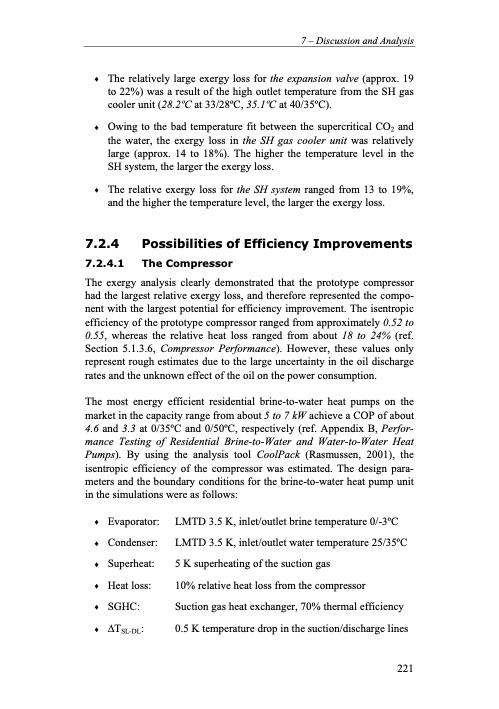
PDF Publication Title:
Text from PDF Page: 243
♦ The relatively large exergy loss for the expansion valve (approx. 19 to 22%) was a result of the high outlet temperature from the SH gas cooler unit (28.2oC at 33/28oC, 35.1oC at 40/35oC). ♦ Owing to the bad temperature fit between the supercritical CO2 and the water, the exergy loss in the SH gas cooler unit was relatively large (approx. 14 to 18%). The higher the temperature level in the SH system, the larger the exergy loss. ♦ The relative exergy loss for the SH system ranged from 13 to 19%, and the higher the temperature level, the larger the exergy loss. 7.2.4 Possibilities of Efficiency Improvements 7.2.4.1 The Compressor The exergy analysis clearly demonstrated that the prototype compressor had the largest relative exergy loss, and therefore represented the compo- nent with the largest potential for efficiency improvement. The isentropic efficiency of the prototype compressor ranged from approximately 0.52 to 0.55, whereas the relative heat loss ranged from about 18 to 24% (ref. Section 5.1.3.6, Compressor Performance). However, these values only represent rough estimates due to the large uncertainty in the oil discharge rates and the unknown effect of the oil on the power consumption. The most energy efficient residential brine-to-water heat pumps on the market in the capacity range from about 5 to 7 kW achieve a COP of about 4.6 and 3.3 at 0/35oC and 0/50oC, respectively (ref. Appendix B, Perfor- mance Testing of Residential Brine-to-Water and Water-to-Water Heat Pumps). By using the analysis tool CoolPack (Rasmussen, 2001), the isentropic efficiency of the compressor was estimated. The design para- meters and the boundary conditions for the brine-to-water heat pump unit in the simulations were as follows: ♦ Evaporator: ♦ Condenser: ♦ Superheat: ♦ Heat loss: ♦ SGHC: ♦ ∆TSL-DL: LMTD 3.5 K, inlet/outlet brine temperature 0/-3oC LMTD 3.5 K, inlet/outlet water temperature 25/35oC 5 K superheating of the suction gas 10% relative heat loss from the compressor Suction gas heat exchanger, 70% thermal efficiency 0.5 K temperature drop in the suction/discharge lines 7 – Discussion and Analysis 221PDF Image | Residential CO2 Heat Pump System for Combined

PDF Search Title:
Residential CO2 Heat Pump System for CombinedOriginal File Name Searched:
20559406.pdfDIY PDF Search: Google It | Yahoo | Bing
CO2 Organic Rankine Cycle Experimenter Platform The supercritical CO2 phase change system is both a heat pump and organic rankine cycle which can be used for those purposes and as a supercritical extractor for advanced subcritical and supercritical extraction technology. Uses include producing nanoparticles, precious metal CO2 extraction, lithium battery recycling, and other applications... More Info
Heat Pumps CO2 ORC Heat Pump System Platform More Info
| CONTACT TEL: 608-238-6001 Email: greg@infinityturbine.com | RSS | AMP |